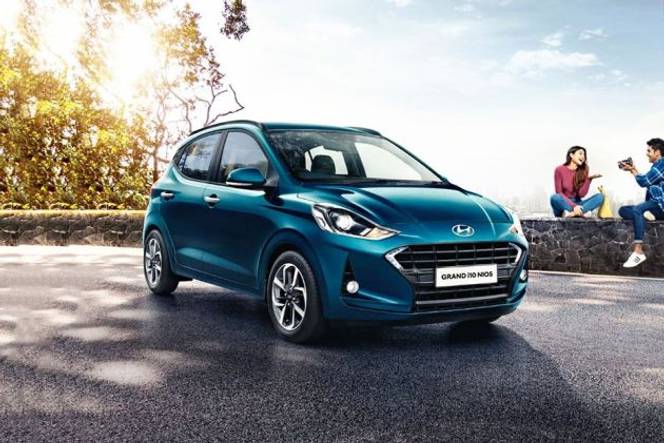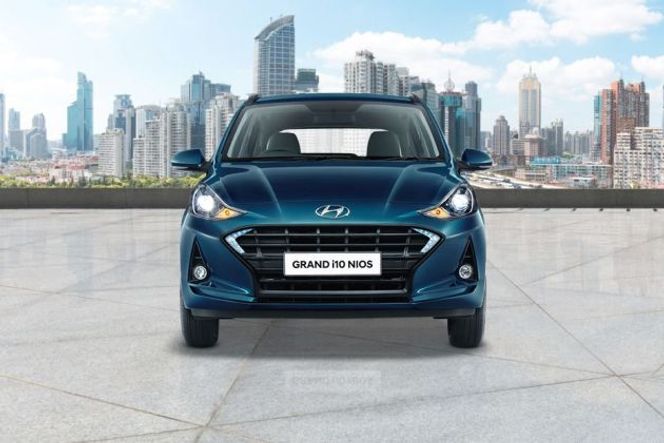 + 7Colours
+ 7Colours + 49Images
+ 49Images
 Videos
Videos
Hyundai Grand i10 Nios 2019-2023
Recommended used Hyundai Grand i10 Nios 2019-2023 cars in New Delhi
Hyundai Grand i10 Nios 2019-2023 specs & features
| Engine | 998 cc - 1197 cc |
| Power | 68.05 - 98.63 bhp |
| Torque | 95.2 Nm - 190.24 Nm |
| Transmission | Manual / Automatic |
| Mileage | 26.2 kmpl |
| Fuel | Petrol / Diesel / CNG |
- Digital Odometer
- Air Conditioner
- Rear AC Vents
- Android Auto/Apple CarPlay
- Automatic Climate Control
- Rear Camera
- Wireless Charger
- Engine Start/Stop Button
- Lane Change Indicator

Wireless phone charging. Charge your phones without messy cables! Wireless phone charging

Hyundai i-Blue App lets you control the infotainment system via a phone app. i-Blue App

Projector fog lamps are a segment first. Projector Fog Lamps
- Key Specifications
- Top Features
- Stand Out Features
Hyundai Grand i10 Nios 2019-2023 price list (Variants)
Following details are the last recorded, and the prices may vary depending on the car's condition.
| Grand i10 Nios 2019-2023 Era(Base Model)1197 cc, Manual, Petrol, 20.7 kmpl | ₹5.54 Lakh* | |
| Magna Corp Edition1197 cc, Manual, Petrol, 20.7 kmpl | ₹6.16 Lakh* | |
| Grand i10 Nios 2019-2023 Magna1197 cc, Manual, Petrol, 20.7 kmpl | ₹6.23 Lakh* | |
| Grand i10 Nios 2019-2023 Corp Edition1197 cc, Manual, Petrol | ₹6.33 Lakh* | |
| AMT Magna Corp Edition1197 cc, Automatic, Petrol, 20.7 kmpl | ₹6.69 Lakh* | |
| Grand i10 Nios 2019-2023 Sportz1197 cc, Manual, Petrol, 20.7 kmpl | ₹6.92 Lakh* | |
| Grand i10 Nios 2019-2023 AMT Magna1197 cc, Automatic, Petrol, 20.7 kmpl | ₹6.93 Lakh* | |
| Corp Edition AT1197 cc, Automatic, Petrol | ₹7.04 Lakh* | |
| Sportz Dual Tone1197 cc, Manual, Petrol, 20.7 kmpl | ₹7.21 Lakh* | |
| Grand i10 Nios 2019-2023 Magna CRDi(Base Model)1186 cc, Manual, Diesel, 26.2 kmpl | ₹7.22 Lakh* | |
| Grand i10 Nios 2019-2023 Magna CNG(Base Model)1197 cc, Manual, CNG | ₹7.26 Lakh* | |
| Magna CRDi Corp Edition1186 cc, Manual, Diesel, 26.2 kmpl | ₹7.30 Lakh* | |
| Grand i10 Nios 2019-2023 AMT Sportz1197 cc, Automatic, Petrol, 20.7 kmpl | ₹7.54 Lakh* | |
| Grand i10 Nios 2019-2023 Asta1197 cc, Manual, Petrol, 20.7 kmpl | ₹7.67 Lakh* | |
| Grand i10 Nios 2019-2023 Sportz CNG1197 cc, Manual, CNG, 24 km/kg | ₹7.80 Lakh* | |
| Grand i10 Nios 2019-2023 Sportz CRDi1186 cc, Manual, Diesel, 26.2 kmpl | ₹7.85 Lakh* | |
| Turbo Sportz Dual Tone998 cc, Manual, Petrol, 20.7 kmpl | ₹7.94 Lakh* | |
| Grand i10 Nios 2019-2023 Turbo Sportz998 cc, Manual, Petrol, 20.7 kmpl | ₹8.12 Lakh* | |
| Grand i10 Nios 2019-2023 AMT Asta(Top Model)1197 cc, Automatic, Petrol, 20.7 kmpl | ₹8.17 Lakh* | |
| AMT Sportz CRDi1186 cc, Automatic, Diesel, 26.2 kmpl | ₹8.46 Lakh* | |
| Grand i10 Nios 2019-2023 Asta CRDi(Top Model)1186 cc, Manual, Diesel, 26.2 kmpl | ₹8.51 Lakh* | |
| Grand i10 Nios 2019-2023 Asta CNG(Top Model)1197 cc, Manual, CNG | ₹8.55 Lakh* |
Hyundai Grand i10 Nios 2019-2023 expert review
Exterior
Interior
Safety
Performance
Variants
Verdict
Pros & Cons of Hyundai Grand i10 Nios 2019-2023
Things We Like
- Build quality. Doesn't feel too far off from an i20!
- Space. Generous amount of kneeroom and headroom for rear seat occupants.
- Well equipped: 8" touchscreen, wireless charging, projector headlamps and foglamps- you name it!
Things We Don't Like
- Diesel variants limited to just three. Sportz variant, for example, is AMT only.
- Basics such as rear headrests, rear wiper limited to just the Asta variant.
Hyundai Grand i10 Nios 2019-2023 news
- Latest News
- Must Read Articles
- Road Test
Hyundai Grand i10 Nios 2019-2023 user reviews
- All (324)
- Looks (87)
- Comfort (94)
- Mileage (91)
- Engine (44)
- Interior (65)
- Space (40)
- Price (38)
- More ...
- Latest
- Helpful
- Verified
- Critical
- Excellent Features Loaded CarAfter used 3 years, this is my first car, love to drive in city frequently and highway randomly, car amt smart auto transmittion is smooth, comfort also good in this segment, maintanance cost reasonable and hyundai doing good in service aspects. No worries they will pick and drop.Am satisfied for my car.Read More1
- Good Car In Its SegmentGood car in its price segment better then swift it is a better combination of mileage and features very comfortable car and one and only car having a seat elevation features in base varrient.Read More4
- Grand I10 Nios Ideal For Long DrivesHyundai Grand I10 Nios is a smooth car with fantastic engine uptake, ideal for long family drives. Excellent performance, extremely comfortable inside, and VIP-like looks. It's compact and lightweight, ideal for city traffic.Read More5 2
- Hyundai Grand I10 Nios Gives Good MileageI recently bought the Hyundai Grand i10 Nios in matte finish spark green color. The new design and looks make it more eye candy to everyone. The price range is affordable, and it gives good mileage that is, why I bought it. The driving experience so far has been good. I would recommend it to everyone.Read More12 1
- Grand I10 Nios Is An Affordable CarThe Hyundai Grand i10 Nios is excellent at a reasonable price. Appearance, Interior Design, service, and design. It is the most economical family vehicle. I just bought one. Both the comfort and the driving experience are good. My family likes it, although it is uncomfortably jumpy at highway speeds when loaded.Read More2
- View All Grand i10 Nios 2019-2023 Reviews
Hyundai Grand i10 Nios 2019-2023 latest updates
Price: The hatchback retails from Rs 5.43 lakh to Rs 8.45 lakh (ex-showroom Delhi).
Variants: It is offered in four trims: Era, Magna, Sportz and Asta.
Engine and Transmission: Hyundai offers two petrol engines: a 1.2-litre engine, making 83PS and 114Nm, that is coupled with either a five-speed manual or a five-speed AMT, and a 1-litre turbocharged unit, delivering 100PS and 172Nm, that is only available with a five-speed manual. The Magna and Sportz CNG variants are also available with a five-speed manual gearbox.
Features: Features on board the Grandi10 Nios include an eight-inch touchscreen infotainment system with Android Auto and Apple CarPlay, a wireless phone charger, auto AC with rear vents, keyless entry and a height-adjustable driver seat.
Safety: On the safety front, it gets dual front airbags, rear parking sensors and ABS with EBD.
Rivals: The Grand i10 Nios directly rivals the Maruti Suzuki Swift. If you're looking for a seven-seater in a similar price range, consider the Renault Triber.
2023 Hyundai Grand i10 Nios: Hyundai has launched the facelifted Grand i10 Nios.
Hyundai Grand i10 Nios 2019-2023 images
Hyundai Grand i10 Nios 2019-2023 has 49 images, view picture gallery of Grand i10 Nios 2019-2023 which includes exterior, interior & 360 view of Hatchback car.
Questions & answers
- FAQ
- Latest Questions
A ) We regret to inform you that currently Hyundai Grand i10 Nios is not available i...Read More
A ) The mileage of Hyundai Grand i10 Nios ranges from 18.5 Km/Kg to 20.7 Kmpl. The c...Read More
A ) Hyundai Grand i10 Nios has leveled up on space, style, and features. The drive e...Read More
A ) Hyundai Grand i10 Nios Sportz CNG is a 5 seater CNG car. Grand i10 Nios Sportz C...Read More
A ) As of now, the brand has not revealed the mileage details of CNG Magna. We would...Read More
Trending Hyundai cars
- Popular
- Upcoming
 Hyundai i20Rs.7.04 - 11.25 Lakh*
Hyundai i20Rs.7.04 - 11.25 Lakh* Hyundai Grand i10 NiosRs.5.98 - 8.62 Lakh*
Hyundai Grand i10 NiosRs.5.98 - 8.62 Lakh* Hyundai ExterRs.6 - 10.51 Lakh*
Hyundai ExterRs.6 - 10.51 Lakh* Hyundai AuraRs.6.54 - 9.11 Lakh*
Hyundai AuraRs.6.54 - 9.11 Lakh* Hyundai CretaRs.11.11 - 20.50 Lakh*
Hyundai CretaRs.11.11 - 20.50 Lakh*

